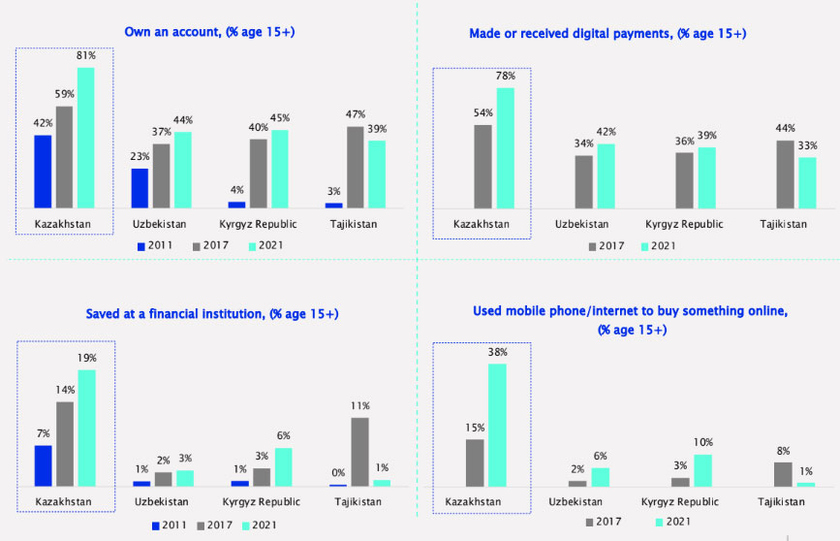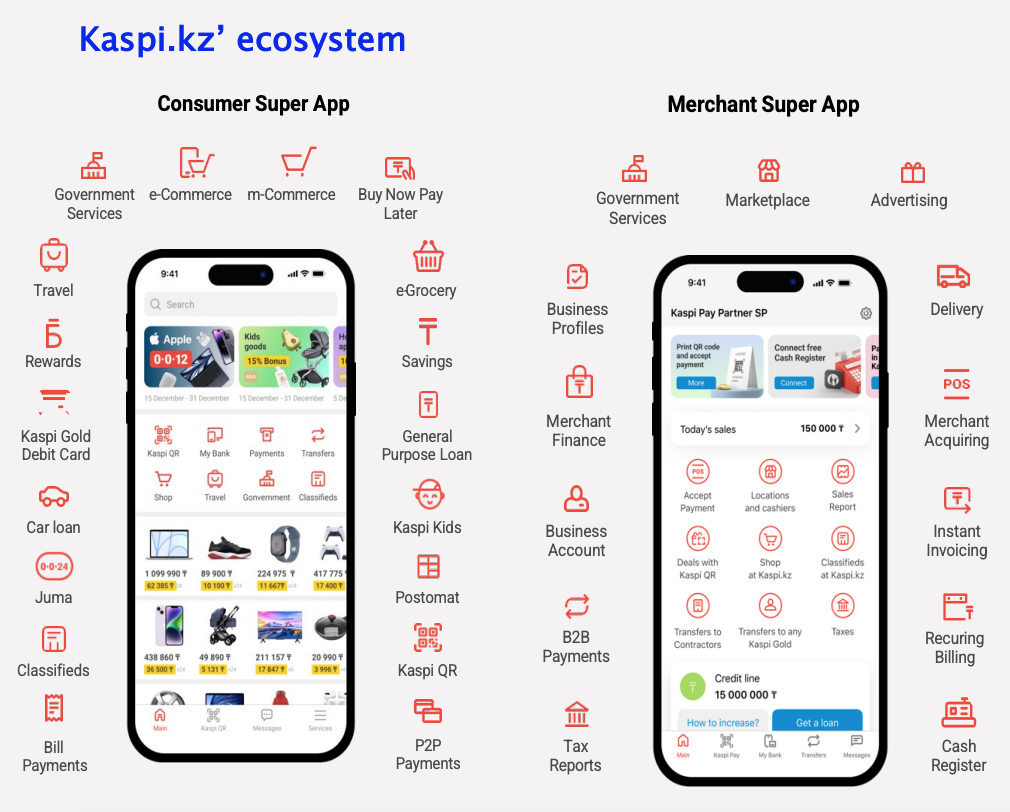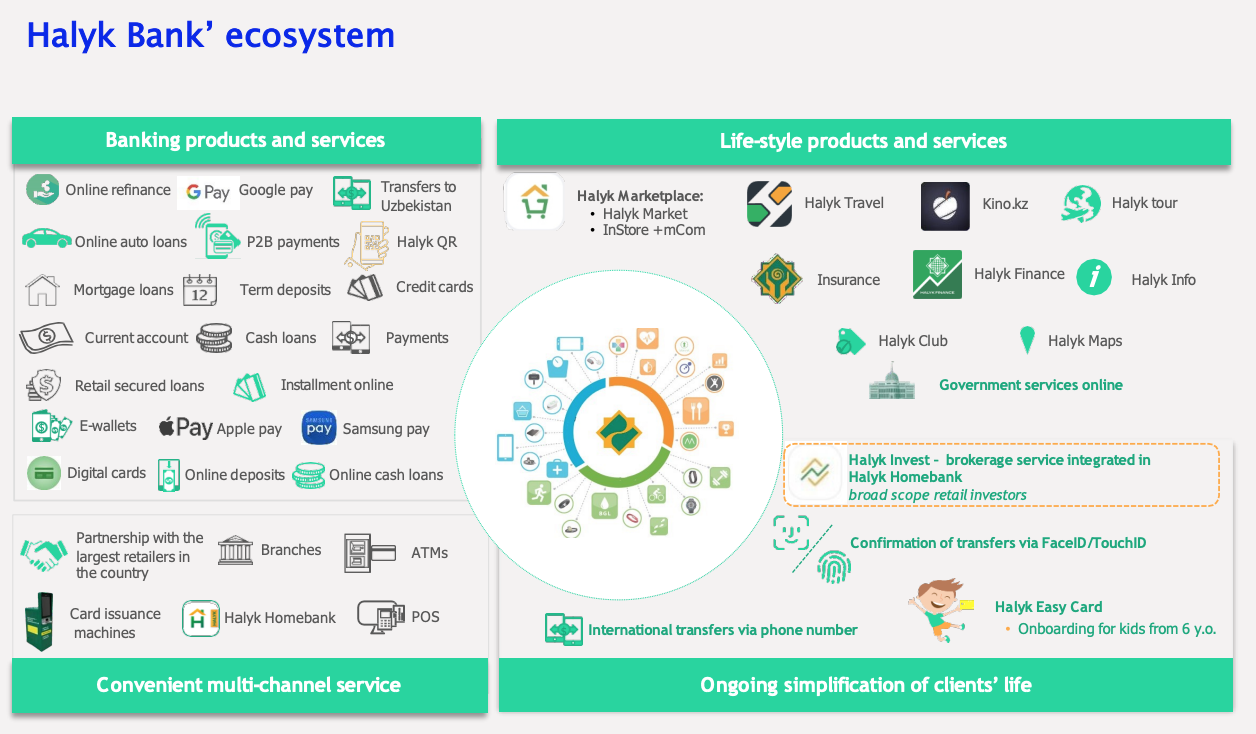Kazakhstan’s fintech market stands out as the largest in Central Asia, with remarkable growth rates that place it among the fastest-growing fintech markets in Asia. With high rates of account ownership (more than 80%) and widespread internet access (more than 90%), Kazakhstani consumers are actively embracing digital payment methods. In this article, we delve into the key trends shaping the fintech industry in 2023.
Several key factors contribute to Kazakhstan’s fintech success story. First and foremost, the country benefits from a favorable business environment and robust banking infrastructure. Moreover, supportive government policies and fintech regulations coupled with a tech-savvy population eager to embrace digital solutions indicate a strong appetite for fintech services and investment opportunities.
The financial services industry and innovations in the market are primarily driven by traditional banks, which have embraced digitalization and technology to maintain the lead in a highly competitive market. Established enterprises in telco, payments, investing, etc. experimenting with product development, expanding and impacting the fintech domain.

Trend 1: Explosive Growth in Digital Payments and E-commerce
Digital payments and e-commerce have experienced exponential growth in Kazakhstan due to technological advancements, regulatory changes, high demand, and increased market competition.
- The volume of cashless transactions increased from $5 bln in 2017 to $158 bln in 2022 (CAGR + 98%)
- Internet and mobile banking dominate cashless payments, accounting for a substantial 82% of all such transactions in 2022.
- The number of users of online banking services increased by 78% annually.

At the same time, merchants are deploying point-of-sale (POS) terminals at a steady pace to adjust to changing consumer behavior. In 2017, 108k POS devices were in operation in Kazakhstan, a number that rose to 831k in 2023. The figures suggest a 70%+ annual growth rate in the number of POS terminals deployed in the country.

Technological advancements like biometrics, advanced data analytics, instant transfers, digital consent management, Open Banking, and Central Bank Digital Currencies (CBDCs) have reshaped the payment landscape.
Trend 2: Mandating Open Banking Implementation
Kazakhstan is planning to make open API and open banking mandatory for the banking sector, aligning its financial regulations with European standards. The
“Concept for the Development of Open API and Open Banking” demonstrates the willingness of consumers, fintech firms, and traditional financial institutions to create essential infrastructure for digital financial integration. Factors such as cross-industry integration, digitization of public services, and open data initiatives are accelerating digital transformation within the financial market.
Projects like
Smart Bridge, the “electronic government” payment gateway, and the “Open Government” portal demonstrate this commitment. The government’s view of financial organizations as access points to government services and digital documents is a win-win strategy, promoting efficiency for both citizens and institutions. Banks increase transactional activity and cross-sales, while the government gains access to the distribution channels of banks and their digital services.
Trend 3: Rise of Ecosystems and Super-Apps
Kazakhstan boasts an impressive 86% mobile banking adoption rate, driving the rise of ecosystems. These ecosystems offer a range of services through a single application, combining financial and non-banking services such as online payments, mobile banking, e-commerce, investment, insurance and lifestyle. The competition among banks to provide more services integrated into their ecosystems is intense, with
Kaspi.kz being a pioneer in this area since 2014. Kaspi.kz has amassed a customer base of 12.6 mln monthly active users, equivalent to around 65% of Kazakhstan’s population.

To keep up with the trend, five more banks in the country have recently opened their e-commerce platforms. Traditional banks like
Halyk Bank are actively developing and deploying their fintech ecosystems and super-apps. These integrated platforms offer not only standard banking services but also lifestyle services such as cinema, weather, commerce, and travel.

Trend 4: Digital SMEs
Small and medium-sized businesses (SMEs) are leveraging digital channels to promote their products and services. The adoption of digital payment methods among SMEs is on the rise. Financial institutions are tapping into non-traditional data sources, including inventory management and customer feedback, to enhance credit scoring models. Information related to inventory management and customer feedback empowers banks to make more informed lending decisions, thereby reducing the risks associated with delayed loan repayments.
Additionally, B2B fintech services are experiencing robust growth, offering a wide range of solutions including invoicing, accounting, payment processing, as well as HR and legal support to cater to the evolving needs of businesses in this digital age.

Trend 5: Democratization of Capital Markets
Wealthtech and digital trading platforms have recorded sustained growth these past years, on the back of legislative changes and technological advancements. Legislative changes in 2020 have ushered in more retail investors in Kazakhstan. Second-tier banks can now offer brokerage services to individuals. Investment mobile apps have democratized stock market access, simplifying remote business relationships through biometric identification services. This move has eliminated the need for traditional signatures and identity cards. Mobile investment apps have played a pivotal role in democratizing stock trading, evident in the substantial growth of retail investor accounts from 119k in 2019 to 581k in 2022.

Trend 6: CBDC Digital Tenge
Kazakhstan’s National Bank is actively developing CBDC known as the
Digital Tenge. This initiative aims to provide a new payment option, with plans for phased implementation in 2023. The Digital Tenge will utilize an open-source distributed ledger and be issued in token form. Payment options will encompass NFC, QR codes, biometrics, and offline methods.
- In 2023, Kazakhstan will launch the digital tenge in three phases. The first phase integrates government payments and procurement processes.
- Piloting Innovation: Government institutions and social support schemes will test the digital tenge’s capabilities through pilot programs.
- Consumer Access: By late 2023, everyday consumers will access the digital tenge for selected benefits and transactions, promising offline payment options.
In conclusion, Kazakhstan’s fintech sector is marked by remarkable growth, progressive regulatory measures, and a tech-savvy population. It presents a compelling destination for both domestic and international fintech investors and companies seeking opportunities in a dynamic and burgeoning market.
- SEO Powered Content & PR Distribution. Get Amplified Today.
- PlatoData.Network Vertical Generative Ai. Empower Yourself. Access Here.
- PlatoAiStream. Web3 Intelligence. Knowledge Amplified. Access Here.
- PlatoESG. Automotive / EVs, Carbon, CleanTech, Energy, Environment, Solar, Waste Management. Access Here.
- PlatoHealth. Biotech and Clinical Trials Intelligence. Access Here.
- ChartPrime. Elevate your Trading Game with ChartPrime. Access Here.
- BlockOffsets. Modernizing Environmental Offset Ownership. Access Here.
- Source: https://www.finextra.com/blogposting/24843/fintech-in-kazakhstan-major-fintech-trends-shaping-the-industry?utm_medium=rssfinextra&utm_source=finextrablogs



